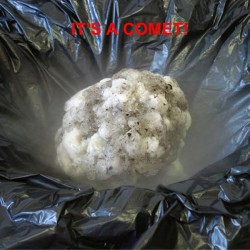 View larger
View larger
Recipe for a Comet
New activity
Create a “comet” using dry ice and household ingredients and use (optional) tools to observe how it models the features of a real comet.
Open Activity
How-to Video
Teacher's Guide
Provides classroom connections, key concepts, connections to science standards, and additional resources.
-
Rating
-
Participants Enjoyed the ActivityParticipants Learned from This ActivityActivity Instructions Were Clear and Easy to FollowWould Recommend
Related Programming Resources
| Hints for uses in your library | This demonstration uses dry ice (frozen carbon dioxide). This substance is extremely cold — never touch (or allow others to touch) dry ice with bare hands, and wear eye protection. Dry ice vaporizes to form gaseous carbon dioxide. Use adequate ventilation to avoid asphyxiation and always keep dry ice in a ventilated container so that pressure does not build up. |
| Related Links |
Websites:
• Night Sky Network (of NASA's Jet Propulsion Lab) • The Web's leading source of Information about Dry Ice • What's in the Heart of a Comet? Videos: • Impact Earth • NASA’s Eyes on the Solar System: learn about our home planet, our solar system, the universe beyond, and the spacecraft exploring them with this downloadable application Handouts: • “Comets vs. Asteroids!” Images: • NASA Solar System Exploration • Planetary PhotoJournal (NASA/JPL) • Printed image of a comet Is a comet currently visible in your night sky? Use the Night Sky Planner to see which objects are bright, and In the Sky to check out all of the comets! This demonstration is helpful for explaining why comets have tails as they approach the Sun. Night Sky Planner In the Sky The bits of comets that fall off when they get close to the Sun are what often cause meteor showers here on Earth. When that happens, we are passing through the trail where a comet once passed. Find out which comets produce some of the annual meteor showers For some great activities to use with younger audiences, see NASA's Solar System Exploration site. It also talks about how the tail of a comet always points away from the Sun. NASA's Solar System Exploration site |
| Originating Source | Regents of the University of California/Astronomical Society of the Pacific |
| Related Books [Suggest a book] |
• 20 fun facts about asteroids and comets by Arielle Chiger and Adrienne Houk Maley
• Asteroids and comets by Ian Graham • Collision course! Cosmic impacts and life on Earth by Fred Bortz |
Reviews
Cooking up comets
We have done this for two different programs, once with teens (they LOVED it!) and once with mixed-age elementary school children at the after school program. They liked it as well, but perhaps didn't get as much from the science behind it as they were in awe of the dry ice vapors. Well-received by both groups, either way. We substituted root beer for the "simple syrup or corn syrup" part of the recipe and let participants drink some of that to balance out the fact that this was a little more hand- off of a project due to the potential hazards involved with the dry ice. We'll be doing it again this year for summer reading 2019.
Comet crafting!
We did this as an activity at a librarian conference. What a great idea! Very hands-on (definitely for older kids given the dry ice). Messy and fun way to learn about comet structure.



